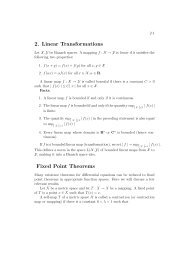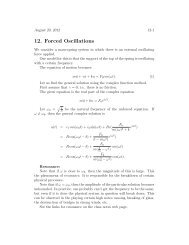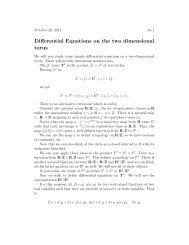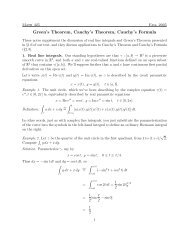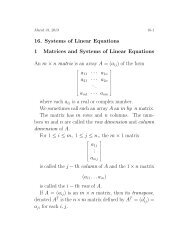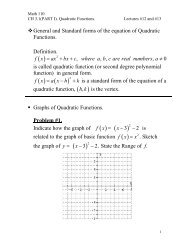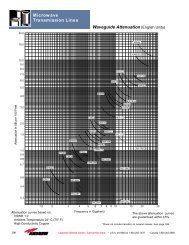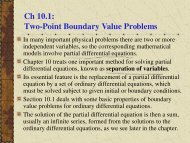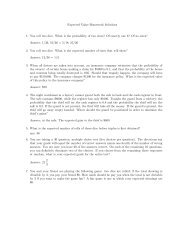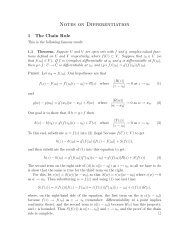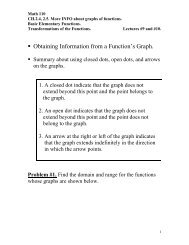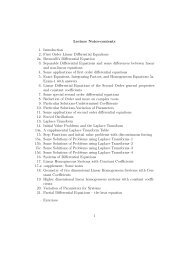Differential Equations on the two dimensional torus 1 Constant ...
Differential Equations on the two dimensional torus 1 Constant ...
Differential Equations on the two dimensional torus 1 Constant ...
Create successful ePaper yourself
Turn your PDF publications into a flip-book with our unique Google optimized e-Paper software.
November 1, 2010 9b-7with r ≥ 1.Thus, <strong>the</strong> image of η is disjoint from <strong>the</strong> Y − axis, and <strong>the</strong> tangent vectorsto η never vanish.The surface obtained by revolving η about <strong>the</strong> Y −axis can be parametrizedbyγ(t, θ) = (X(t)cos(2πθ), Y (t), X(t)sin(2πθ))with 0 < θ < 1).Thus, <strong>the</strong> map γ : (a, b)×(0, 1) → R 3 is a C r embedding from (a, b)×(0, 1)into R 3 . Its image is <strong>the</strong> surface of revoluti<strong>on</strong> determined by η and <strong>the</strong> Y −axis.Next, c<strong>on</strong>sider <strong>the</strong> open unit box in R 2 given by (0, 1) × (0, 1). We usethis to parametrize an open dense set of a <strong>torus</strong> of revoluti<strong>on</strong> in R 3 as follows.Let 0 < r < R be <strong>two</strong> positive real numbers.C<strong>on</strong>sider <strong>the</strong> embedding η from (0, 1) into <strong>the</strong> X − Y −plane given byη(t) = (R + r cos(2πt), r sin(2πt), 0) = (X(t), Y (t), 0)This maps (0, 1) <strong>on</strong>to <strong>the</strong> circle{(X, Y, 0) : (X − R) 2 + Y 2 = r 2 }with a point removed.Using this to parametrize <strong>the</strong> surface obtained by revolving η about <strong>the</strong>Y −axis, we get <strong>the</strong> map Φ : (0, 1) × (0, 1) → R 3 defined byΦ(t, θ) = ((R + rcos(2πt)cos(2πθ), r sin(2πt), (R + rcos(2πt)sin(2πθ)).The image is an open <strong>torus</strong> of revoluti<strong>on</strong> with <strong>two</strong> circles removed. Theimage is dense in <strong>the</strong> <strong>torus</strong> of revoluti<strong>on</strong>.C<strong>on</strong>sider <strong>the</strong> height functi<strong>on</strong> h(X, Y, Z) = Z from R 3 to R. This functi<strong>on</strong>is defined as a C ∞ functi<strong>on</strong> <strong>on</strong> all of R 3 , and, in particular <strong>on</strong> <strong>the</strong> closure of<strong>the</strong> image of Φ.This gives a functi<strong>on</strong> ψ(t, θ) from (0, 1) × (0, 1) to R defined byψ(t, θ) = (R + rcos(2πt))sin(2πθ)Replacing t by x and θ by y, and still using ψ to denote <strong>the</strong> functi<strong>on</strong>, wehave



